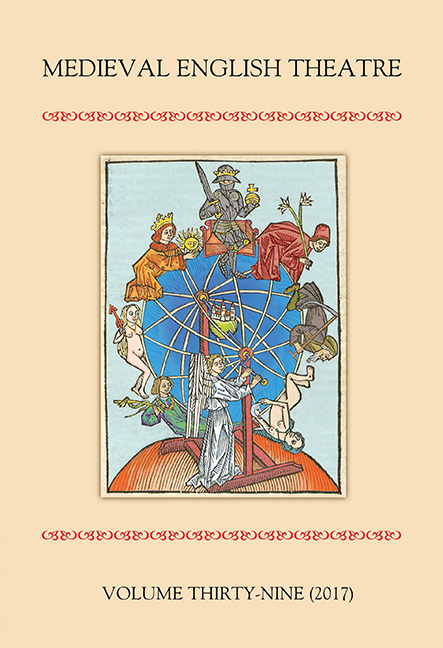Book contents
- Frontmatter
- Contents
- List of Illustrations
- Editorial
- Online Links
- Pageant-Carriage Maintenance at Chester
- Carnevale in Norwich, 1443: Gladman's Parade and its Continental Connections
- The Beccles Game Place and Local Drama in Early North-East Suffolk
- Pendens super feretrum: Fergus, Aelred, and the York ‘Funeral of the Virgin’
- George Gascoigne at Oxford
- Elizabeth Nevile's Wedding Entertainments: A Yorkshire Family Celebration in 1526 and its Contexts
- Herod's Killing of the Children in New College Chapel Oxford, 8 February 2017 (review)
- Editorial Board and Submissions
Herod's Killing of the Children in New College Chapel Oxford, 8 February 2017 (review)
Published online by Cambridge University Press: 17 July 2019
- Frontmatter
- Contents
- List of Illustrations
- Editorial
- Online Links
- Pageant-Carriage Maintenance at Chester
- Carnevale in Norwich, 1443: Gladman's Parade and its Continental Connections
- The Beccles Game Place and Local Drama in Early North-East Suffolk
- Pendens super feretrum: Fergus, Aelred, and the York ‘Funeral of the Virgin’
- George Gascoigne at Oxford
- Elizabeth Nevile's Wedding Entertainments: A Yorkshire Family Celebration in 1526 and its Contexts
- Herod's Killing of the Children in New College Chapel Oxford, 8 February 2017 (review)
- Editorial Board and Submissions
Summary
This performance on 8 February 2017, by the New College Players and the Frideswide Voices and directed by Elisabeth Dutton, gained much from its setting in the chapel at New College, Oxford. The feeling that this was a place used regularly for worship helped, with certain physical characteristics to enhance it, including an echo. There was a strong musical element, including dancing, in the performance and many of the actors and singers were women or young girls. This accorded with the text which unusually asks for ‘virgynes’ (line 477). Here women also acted some of the male parts, including an impressive performance of the Poet, who introduced and concluded the play. The slaughtered children were represented by dolls. There was a strong character contrast between Herod who boasted his way to madness and a grotesque destruction, and the virtuous Simeon, who in this production carried a live baby able to sit up and look beneficently at the audience (without needing an understudy). The latter was a fitting part in a play which in performance had a strong emotional appeal, much helped by the music. The episode of the slaughter was disturbing, especially when it came to a frozen pause as one of the Knights held his spear aloft, impaling a dead baby. It was at this point that both modern and late medieval audiences might have anticipated the Crucifixion yet to come, as well as other mass extermination. As a complement the baby in the arms of Simeon might have echoed the many images of the Madonna and Child, as well as the brief appearance of Mary with the child earlier.
Some doubt arises in the text about the order of the two main events, as the Poet in the introduction puts the Presentation first, with the Killing to follow. In this performance the reverse order, as in the text itself, seemed well supported on emotional grounds as the horror of the murders gave way after angelic intervention to the thankful ending centring upon Simeon.
The text is well provided with stage directions and this performance made good use of them.
- Type
- Chapter
- Information
- Medieval English TheatreVolume Thirty-Nine (2017), pp. 158 - 159Publisher: Boydell & BrewerPrint publication year: 2018



